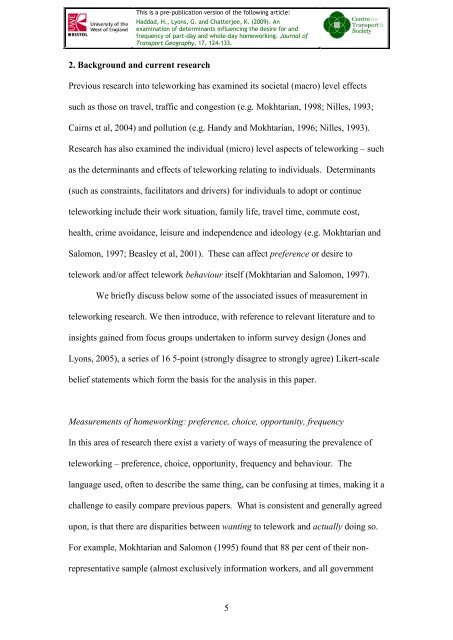Haddad, H. , Lyons, G. and Chatterjee, K. (2009) - UWE Research ...
Haddad, H. , Lyons, G. and Chatterjee, K. (2009) - UWE Research ...
Haddad, H. , Lyons, G. and Chatterjee, K. (2009) - UWE Research ...
You also want an ePaper? Increase the reach of your titles
YUMPU automatically turns print PDFs into web optimized ePapers that Google loves.
This is a pre-publication version of the following article:<br />
<strong>Haddad</strong>, H., <strong>Lyons</strong>, G. <strong>and</strong> <strong>Chatterjee</strong>, K. (<strong>2009</strong>). An<br />
examination of determinants influencing the desire for <strong>and</strong><br />
frequency of part-day <strong>and</strong> whole-day homeworking. Journal of<br />
Transport Geography, 17, 124-133.<br />
2. Background <strong>and</strong> current research<br />
Previous research into teleworking has examined its societal (macro) level effects<br />
such as those on travel, traffic <strong>and</strong> congestion (e.g. Mokhtarian, 1998; Nilles, 1993;<br />
Cairns et al, 2004) <strong>and</strong> pollution (e.g. H<strong>and</strong>y <strong>and</strong> Mokhtarian, 1996; Nilles, 1993).<br />
<strong>Research</strong> has also examined the individual (micro) level aspects of teleworking – such<br />
as the determinants <strong>and</strong> effects of teleworking relating to individuals. Determinants<br />
(such as constraints, facilitators <strong>and</strong> drivers) for individuals to adopt or continue<br />
teleworking include their work situation, family life, travel time, commute cost,<br />
health, crime avoidance, leisure <strong>and</strong> independence <strong>and</strong> ideology (e.g. Mokhtarian <strong>and</strong><br />
Salomon, 1997; Beasley et al, 2001). These can affect preference or desire to<br />
telework <strong>and</strong>/or affect telework behaviour itself (Mokhtarian <strong>and</strong> Salomon, 1997).<br />
We briefly discuss below some of the associated issues of measurement in<br />
teleworking research. We then introduce, with reference to relevant literature <strong>and</strong> to<br />
insights gained from focus groups undertaken to inform survey design (Jones <strong>and</strong><br />
<strong>Lyons</strong>, 2005), a series of 16 5-point (strongly disagree to strongly agree) Likert-scale<br />
belief statements which form the basis for the analysis in this paper.<br />
Measurements of homeworking: preference, choice, opportunity, frequency<br />
In this area of research there exist a variety of ways of measuring the prevalence of<br />
teleworking – preference, choice, opportunity, frequency <strong>and</strong> behaviour. The<br />
language used, often to describe the same thing, can be confusing at times, making it a<br />
challenge to easily compare previous papers. What is consistent <strong>and</strong> generally agreed<br />
upon, is that there are disparities between wanting to telework <strong>and</strong> actually doing so.<br />
For example, Mokhtarian <strong>and</strong> Salomon (1995) found that 88 per cent of their non-<br />
representative sample (almost exclusively information workers, <strong>and</strong> all government<br />
5

















